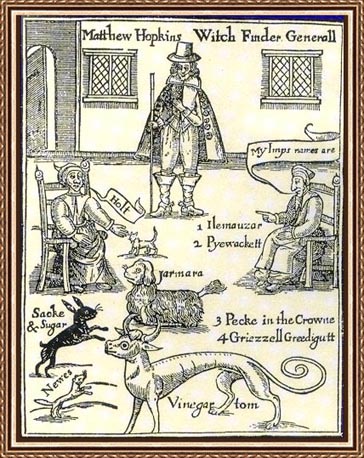 This is a woodcut from around 1647 depicting the familiars of Elizabeth Clark. There are five familiars; a cat, two dogs, a polecat, and a rabbit. Familiars are the “historically, low-ranking demons in constant attention to witches for the purpose of carrying out spells and bewitchment's” (Guiley). They are the ones who usually do the physical harm to the person being cursed. The witch would feed them blood, usually from a third 'teat'. This symbolizes the physical bond that the witch has with her familiars.
This is a woodcut from around 1647 depicting the familiars of Elizabeth Clark. There are five familiars; a cat, two dogs, a polecat, and a rabbit. Familiars are the “historically, low-ranking demons in constant attention to witches for the purpose of carrying out spells and bewitchment's” (Guiley). They are the ones who usually do the physical harm to the person being cursed. The witch would feed them blood, usually from a third 'teat'. This symbolizes the physical bond that the witch has with her familiars.At the top of this woodcut is Matthew Hopkins, the most famous English witch-hunter. I find it interesting that he is in the woodcut with the familiars because it shows that the familiars must have come to Elizabeth even after she was accused of being a witch. I would think that the familiars would stay away from her while Hopkins was there, because they would be strong proof that she was a witch. If she was found guilty of witchcraft the familiars would have to find another person, usually a woman, to be their sponsoring witch.
In this woodcut Elizabeth also names all of her familiars. The little dog's name is Jamara, the large dog is Vinegar Tom, the cat is Holt, the polecat is Newes, and the rabbit is Sack and Sugar. I find these to be interesting names because they don't all seem to have anything to do directly with witchcraft. I do not know what Jamara means, but I reminds me of Jamaica and the superstitions that the country holds. I know that Jamacia wasn't an influence on early modern England, but I still find it interesting that the two seem to be connected through witchcraft. The other dog's name, Vinegar Tom, seems like it might be a description of the kind of things he does. He, like vinegar, is not sweet but sour. Vinegar Tom would not be appearing to you in order to do something that would benefit you, but something that would sour your life. For the cat, the only thing I can some up with is the Oxford English Dictionary definition of the word; "a place of refuge or abode; a lurking-place; an animal's lair or den". The cat's name might signify the fact that he is hidden to everyone besides the witch and/or is something that will come lurking around your home and cause harm to you and your family. The polecat, Newes, I find strange all round. I have found that a polecat is related to a weasel and that makes the use of polecats a little clearer in connection to witches. Weasels are considered to be sneaky creatures, and since the polecat is related, they also share that stigma. As for his name, Newes might be for the fact that he brings ill news to the people his master has cursed. There is probably a better explanation, but I cannot think of one. The last familiar in this woodcut is the rabbit; Sack and Sugar. I find it interesting that the name is not 'sack of sugar', although it might just have this curiosity because the English language was different than what it is today. This familiar seems to have a positive connotation as opposed to the negative names of the others. I think this name might be positive because it is positive for the witch. The rabbit helps her do her evil acts and this brings sweetness to the witches life just as sugar sweetens food. Rabbits have been associated with witches for a long time, although today they are basically associated with good magician pulling them out of a hat. I wonder how rabbits became part of the witches association because they do not seem to have anything inherently evil about them. I also find it interesting that the familiars are all named in the woodcut. For some reason I figured that the familiars would not be named because then everyone would know about the familiars and they would somehow not just be the witches 'pets' anymore.
I am also interested in knowing why there are two women in the woodcut and why there names are Ilemauzar and Pyewackett. From what I have found the familiars belong to Elizabeth Clarke and so I don't understand who these women are. Do they have something to do with Elizabeth, or do the familiars belong to them and not to Elizabeth.
This woodcut inspires many questions about witchcraft in early modern England. Some of the aspects of the woodcut seem to inforce what I have learned about witches, but some of the things leave me with more questions than answers.
Picture:http://images.google.com/imgres?imgurl=http://special.lib.gla.ac.uk/images/exhibitions/damned/dadisc.gif&imgrefurl=http://special.lib.gla.ac.uk/exhibns/damnedart/index.html&usg=__hHYLXA2pdEwsn1eGk0rWDDnQTtI=&h=1077&w=800&sz=376&hl=en&start=6&um=1&tbnid=gGPedMf97AJ06M:&tbnh=150&tbnw=111&prev=/images%3Fq%3Dhopkins%2Bwitch%2Bwoodcut%26um%3D1%26hl%3Den%26rlz%3D1T4DKUS_enUS276US281
1 comment:
It continues to be fascinating to me that animals are ever-present in the world of witches. What is the deal with that? It even continues today, in tales such as Harry Potter and the Sorcerer's Stone (as you very well know, :D). There is just something about the companionship of certain creatures that makes us feel that we have their loyalties. It just like the "man's best friend" concept of dogs- why do they make us feel this way? I guess this is the best excuse for why people may be so inclined to include animals in their stories. Additionally, it was most likely always beneficial to utilize animals in cases as proof that had no voice- no objections or oppositional witness! Haha.
Blog was great to read and very interesting! Thanks!
Post a Comment